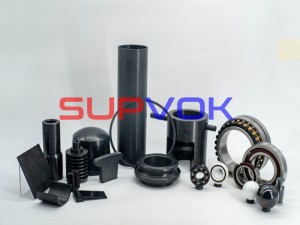-
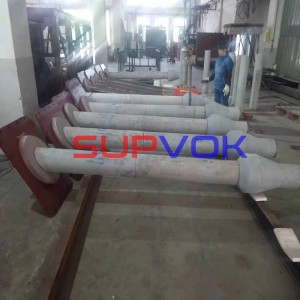
Silicon carbide pipe/nozzles in power plants
Silicon Carbide Products in power plant
The main function of the silicon carbide nozzle of the burner is to inject the pulverized coal air mixture (primary air) supplied by the pulverized coal preparation system and the secondary air required for combustion into the furnace at a certain concentration and speed, respectively, so as to achieve stable ignition and combustion in the suspended state.
- 1. The structure of silicon carbide nozzle must be simple, not easy to block, easy to repair and replace, long service life, and improve economic efficiency.
- 2. The silicon carbide nozzle adopts an integrated casting molding process, which is high temperature resistant, wear-resistant and reduces maintenance costs.
The burner nozzles of power plant generally adopts cast steel structure. The proper swing of the burner nozzle can change the position of the flame center to adjust the reheat steam temperature level; The thick and thin pulverized coal burner can prevent furnace coking and high-temperature corrosion, and has the characteristics of stable ignition, good combustion stability at low load, and low NOx emission. After the primary air cast steel nozzle of the burner is burnt and deformed, the deviation between the furnace flame center and the design value is large, and the deviation between the nozzle size and the original size is large. The initial momentum of the jet is reduced compared with that before the burning loss, the range is shorter, and the rigidity is poor. The pulverized coal ignites near the nozzle, and the temperature near the nozzle is high, which is easy to produce slagging. The primary air nozzle of the burner needs to be replaced after it is burnt. During the replacement, the powder pipes connected to the outside of the burner need to be disconnected, the primary air nozzle of the burner and the nozzle should be pulled out together, then replaced, and then loaded. The workload is large, the environment is poor, and it costs labor, time, and money, resulting in great economic losses.
The silicon carbide nozzle of the burner produced by our company is wear-resistant, high-temperature resistant, non-deformable, and its service life is 3-5 times that of the cast steel nozzle, which improves the boiler efficiency, reduces NOX emissions, saves energy and environmental protection, reduces maintenance costs, and improves economic benefits.
It adopts integrated molding process, which is resistant to high temperature, abrasion and deformation.
The defects of cast steel nozzle mainly include the following aspects.
1. The nozzle of cast steel is not wear-resistant, corrosion resistant, high temperature resistant and has short service life. The boiler needs to be shut down for replacement, resulting in great economic losses.
2. The cast steel nozzle is easy to be damaged during the operation of the unit, and the blunt body of the nozzle often falls off, threatening the operation of the burner and the safe operation of the slag extractor.
3. Because the nozzle material is G40Cr20Ni5, which works under high temperature for a long time, when the combustion of pulverized coal is unstable, it will cause uneven temperature distribution in the furnace or coking at the nozzle, resulting in thermal stress at the nozzle due to temperature difference, resulting in serious local deformation of the nozzle, short range of primary air, poor rigidity, pulverized coal ignition near the nozzle, high temperature near the nozzle, and local additional stress in the component. When the temperature fluctuation is large, The thermal stress changes greatly, causing thermal fatigue cracks on the nozzle surface, which will cause the burner nozzle and nozzle to burn over a long period of time.
4. Because the primary air flow is a high-speed gas-solid two-phase flow, the uneven scouring of pulverized coal particles leads to serious local wear of the blunt body and even wear off the blunt body. The nozzle and the blunt body are integrated. On the other hand, the thermal stress at high temperature is easy to cause serious deformation of the nozzle, even burning out, so the nozzle can not play its due role.
-
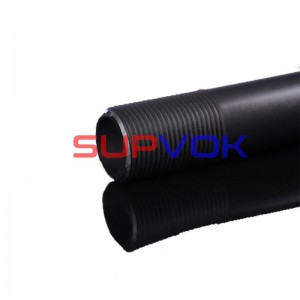
Silicon carbide ceramic bolts
Silicon carbide is an inorganic non-metallic material that is popular in various industries due to its excellent properties. Silicon carbide has the characteristics of high hardness, wear resistance, corrosion resistance, high temperature strength, etc., and is widely used in machinery, metallurgy, chemical industry, electronics and other fields. Especially silicon carbide bolts and screws are attracting attention due to their unique features.
Silicon carbide bolts and screws are engineered to withstand extreme conditions. With their high temperature resistance, these fasteners can operate successfully in high temperature environments, making them suitable for applications in industries such as aerospace and automotive. Additionally, their excellent chemical resistance allows them to withstand harsh chemical reactions without deterioration, increasing their durability and longevity.
The incorporation of grooved silicon carbide pan head screws further enhances its functionality. These notches provide extra grip and stability, keeping the screws securely in place. This capability is especially important in harsh environments where vibration and force are prevalent.
A notable property of silicon carbide bolts and screws is their excellent wear resistance. As mechanical parts requiring wear resistance, these fasteners ensure the system maintains its integrity and performance over time. With silicon carbide’s high hardness and wear resistance, these bolts and screws can withstand abrasive forces and maintain their structural integrity, increasing the overall efficiency and service life of the systems in which they are used.
The chemical resistance of silicon carbide bolts and screws is another key advantage. These fasteners maintain their structural integrity when exposed to corrosive substances common across industries. This chemical resistance ensures that SiC bolts and screws can withstand corrosive environments without compromising their functionality, guaranteeing reliable and efficient performance.
Density g/cm³ >3.12 Vickers hardness GPa 21±2 Bending strength MPa @20 ℃ 390±10 @1450 ℃ 400±10 @1600 ℃ 410±10 Compressive strength
( room temperature)MPa 3900±100 Elastic modulus
( room temperature)GPa 360±10 Fracture toughness
(room temperature)MPa.m1/2 3.8±0.7 Thermal expansion coefficient
(room temperature to 1000°C)x10-6mm/mm°K 4.85 Thermal conductivity
(room temperature)W/m°K 160 Maximum operating temperature
(in air)°C 1650 In general, silicon carbide ceramics have a wide range of excellent properties that make them highly sought after in various fields. In addition to high temperature strength and chemical corrosion resistance, these ceramics also have the characteristics of strong oxidation resistance, good wear resistance, good thermal stability, small thermal expansion coefficient, high thermal conductivity, high hardness, and thermal shock resistance.
These excellent properties have made silicon carbide ceramics widely used in numerous applications. In the petrochemical industry, they are used as corrosion-resistant vessels and pipes. The machinery industry benefits from their use in various bearings, cutting tools and mechanical seal components. In addition, silicon carbide ceramics are being explored as potential materials for gas turbines, rocket nozzles, and engine components in the aerospace and automotive sectors.
In summary, silicon carbide bolts and screws have a unique combination of properties that make them ideal for applications requiring resistance to wear, corrosion, and high temperatures. With their superior durability and reliability, these fasteners offer significant advantages in the aerospace, automotive, machinery and other industries. With the continuous advancement of technology, silicon carbide materials will play an increasingly important role in various fields due to their excellent characteristics and versatility.
When tightening screws, please use a torque driver or torque wrench and do not twist the breaking torque. The recommended torque is 50% of the torsional fracture torque.
Reference value: Torsional fracture torque
M3–0.1N. M
M4-0.2N. M
M5-0.25N. M
Ceramic products may be damaged by impact, please be careful during operation
-
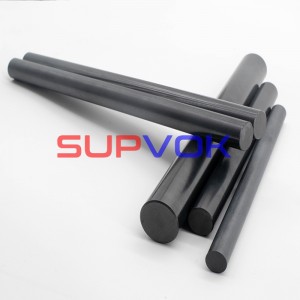
Silicon nitride ceramics
Silicon nitride ceramics are gaining popularity due to their diverse applications and high performance properties. From energy and the environment to the automotive industry, these advanced ceramics play a vital role in enhancing performance, durability and efficiency. In this blog, we will explore the various applications of silicon nitride ceramics and delve into the unique characteristics that set them apart in the market.
One of the main applications of silicon nitride ceramics is the polysilicon reaction reduction furnace. These furnaces require insulating rings, heat shields and insulating bushings that can withstand high temperatures and provide a long service life. Silicon nitride ceramics have proven to be an excellent choice for these components due to their high temperature resistance and durability. By using silicon nitride ceramics, not only can the replacement frequency be reduced, but also cost can be saved, making it an optimal solution for energy and environment related applications.
Another area where silicon nitride ceramics shine is the aluminum foundry industry. The denseness, high temperature strength, thermal shock resistance and corrosion resistance of these ceramics make them highly sought after in various equipment components in this industry. The company has developed a series of high-performance silicon nitride ceramic products tailored for aluminum casting. Silicon nitride risers, heater protection tubes, shafts, rotors and thermocouple protection tubes are some examples of how these ceramics can be used to improve the efficiency and reliability of aluminum casting processes.
Hybrid ceramic bearings, especially those with silicon nitride balls, are also gaining popularity in the market. These bearings have many advantages such as high speed, light weight, self-lubrication, maintenance-free operation and electrical insulation. These properties make them particularly suitable for spindle bearings used in machine tools. The use of silicon nitride ceramics in hybrid bearings not only improves overall performance, but also helps improve energy efficiency and extend product life.
In the automotive industry, silicon nitride ceramics are used in various components. Automotive diesel engines, ceramic brake discs, engine PCU power control systems, and ceramic substrates are some examples of these ceramic applications. Silicon nitride ceramics have a unique combination of properties that make them ideal for these applications. They have high thermal conductivity, with a strength ranging from 600 to 800MPa, a fracture toughness of 6.0-8.0Mpa m1/2, and a thermal conductivity of 80-100/[(mK)], which can cope with the harsh conditions of the automotive environment. In addition, their at least 300 The current carrying capacity and thermal resistance of ≤0.5 (0.5 m Cu)(°C/W) further contribute to its suitability for automotive application.
-
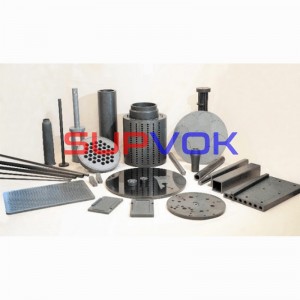
Silicon carbide advanced ceramics
Silicon carbide (SiC)
Features of the product:
Silicon carbide ceramic is the lightest and hardest ceramic material. It has excellent thermal conductivity, low thermal expansion, very acid and alkali resistance, and is not easy to crack in cold and hot environments.
Therefore, silicon carbide ceramic is an excellent furnace material and high-temperature wear-resistant part. It also has excellent corrosion resistance and wear resistance.
Product performance:
Very low density: (3.20 g/cm ³)
Very high hardness: (94HRA)
High thermal conductivity: (80 W/mK)
Low linear expansion coefficient: (4.5×10-6/K-1400 ℃)
Maximum service temperature: 1500 ℃
Maintain good corrosion resistance and wear resistance at high temperature
The outstanding characteristics of SiC ceramics:
Low density, high elastic modulus; High strength, especially high temperature strength and low temperature; High hardness and low friction coefficient, excellent wear resistance; Low thermal expansion coefficient, high thermal conductivity, and excellent thermal shock resistance; Good chemical stability and excellent corrosion resistance; The resistivity can be controlled by purity and doping, and has semiconductor characteristics.
2. SiC Product series:
As structural ceramics and high-temperature materials with excellent performance, SiC ceramics have been used more and more in petrochemical, iron and steel metallurgy, mechanical and electronic, aerospace, energy and environmental protection, nuclear energy, automobile, high-temperature kiln and other industrial fields.
(1) Sealing ring and bearing:
Due to its excellent wear resistance, high thermal conductivity, high temperature resistance and corrosion resistance, pressureless sintering and reactive sintering dense SiC material is an ideal material for manufacturing sealing rings, sliding bearings and friction protection shaft sleeves. It can be processed into sealing rings with various shapes and high dimensional accuracy and surface finish, which can be used as mechanical seals in many harsh environments. For example, the sealing device and sliding device used for acid-resistant and alkali-resistant pumps in the shipbuilding, chemical, metallurgy, petroleum and paper industries have been widely used due to their good air tightness and long service life.
Take the application of SiC sealing ring in surface sealing of automobile water-cooled pump as an example. The face seal mainly provides the seal of the rotating interface to prevent the liquid or gas on one side of the seal from flowing to the other side. For the water-cooled circulating water pump device of automobile engine, the ceramic ring seal can avoid water leakage during the rotation of the water pump, and can realize sealing and sliding at the same time. In the past, Al and O ceramics were commonly used, but now SiC materials are used because SiC has higher hardness, better wear resistance and longer service life than AlO. Similar SiC sealing rings are also used in automobile air conditioning compressors.
(2) Bulletproof ceramic
Due to its high hardness, low density, good protective performance and low price (compared with B4C ceramics), SiC ceramics have certain competitive advantages in the application of bulletproof armor. Its protective performance is better than that of AL2O3 ceramics and slightly inferior to B4C ceramics (about 70%~80% of B4C ceramics), but the manufacturing cost of SiC ceramics is far lower than that of B4C ceramics. At present, normal-pressure sintered SiC and reaction-sintered SiC ceramic plates are particularly suitable for occasions with large amounts of protective armor and cannot be too thick and heavy. For example, SiC ceramics with high hardness, high toughness and high Weibull modulus (four-point bending strength is 580 MPa, fracture toughness Kc is. 7MPam1/2, Weibull modulus m=17) prepared by American companies are excellent bulletproof materials.
(3) Nozzle
Various nozzles are needed in the fields of petroleum industry, energy, environmental protection, aerospace rocket and machinery manufacturing. SiC ceramics are widely used because of their higher hardness, thermal shock resistance and excellent corrosion resistance than Al2O3 and Si3N4 ceramics. For example, the service life of SiC ceramic is 3.5 times longer than that of Al2O3 ceramic. Reactive sintering, pressureless sintering and recrystallized SiC can be used as burner nozzles in high-temperature kilns and desulfurization nozzles for desulfurization and dust removal in thermal power plants.
(4) Grinding plate Grinding plate is an important process equipment for the production of silicon wafers for ultra-large-scale integrated circuits in the semiconductor industry. Generally used cast iron or carbon steel grinding plates have short service life and large thermal expansion coefficient. In the process of processing silicon wafers, especially in high-speed grinding. During polishing, the flatness and parallelism of the silicon wafer are difficult to be guaranteed due to the wear and thermal deformation of the grinding plate. Because of its high hardness and low wear, and its thermal expansion coefficient is basically the same as that of silicon wafers, the grinding disc made of silicon carbide ceramics can be grinded and polished at high speed. In recent years, the size of silicon wafers has become larger and larger, and higher requirements have been put forward for the quality and efficiency of silicon wafers. The use of SiC ceramic abrasive discs will significantly improve the quality and efficiency of silicon wafer grinding. SiC ceramic abrasive discs manufactured by Kyocera Corporation, Toshiba Ceramics Corporation, and Caballendon Corporation of the United States have been used in the semiconductor industry.
(5) High temperature heat exchanger
In many cases, for example, in metal and glass furnaces, furnaces and coal burning furnaces, the gas emitted is not only high temperature but also corrosive, which requires that the heat exchanger also have high temperature resistance, corrosion resistance and thermal shock resistance, and can withstand large thermal stress. Another performance requirement for heat exchanger materials is high thermal conductivity to maximize heat transfer rate and heat exchanger efficiency. SiC has been the main material of industrial heat exchanger for a long time because of its high thermal conductivity, excellent high-temperature resistance, corrosion resistance and good thermal shock resistance. For example, the SiC heat exchanger of steel forging furnace has been put into use for more than 500000 hours since 1985, and the use of SiC heat exchanger in Hao remelting furnace can save 38% of fuel.
(6) Thermal engine parts
The outstanding high temperature strength, excellent high temperature creep resistance and thermal shock resistance of SiC ceramics make it one of the main materials for thermal engine components in rockets, aircraft, automotive engines and gas turbines. For example, the AGT100 automotive ceramic gas turbine developed by General Motors uses SiC ceramics as high-temperature components such as combustor ring, combustor barrel guide vane and turbine rotor. These SiC components are mainly prepared by reactive sintering, pressureless sintering or hot-pressing sintering. Due to the poor toughness of SiC ceramics, they are mainly used as static heat engine components in engines or gas turbines.
(7) High temperature seal
Both recrystallized SiC and solid-phase normal-pressure sintered SiC ceramics are excellent high-temperature sealing materials, which can be used as high-temperature crossbeam sticks, shed plates, saggers, etc., and the service temperature reaches 1600C, as shown in Figure 8-13 (b) and (h). SAINTGOBAIN, France, uses pressureless sintered SiC ceramics to make the beam of high temperature sealing tool, which has the characteristics of self-bonding and fine grain (<10 um) microstructure, and its high temperature strength and oxidation resistance are very excellent. Under the condition that the bending strength at 1700C is maintained above 400 MPa and 1100C wet steam, the oxidation weight gain is far less than that of recrystallized SiC and SiN-bonded SiC ceramics.
-
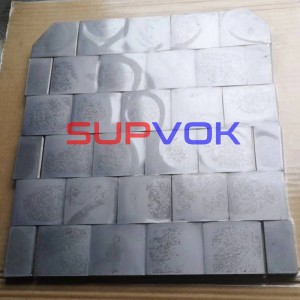
Applications of silicon carbide ceramics in bulletproof fields
Applications of silicon carbide ceramics in bulletproof fields
Ordinary ceramics are brittle. Depending on modern science and technology, they become the advanced ceramics which have good hardness and high-strength. The advanced ceramics should be the new material in bulletproof field with special physical performance requirements. Thus, the ceramics have become a very popular bulletproof material.
01 Bulletproof principle of ceramic materials
The bulletproof is used for consuming projectile energy and slowing down projectile speed in order to minimize the harms on the bulletproof users. Most traditional engineering materials, such as metal and so on, absorb energy through plastic deformation of structure, while ceramic materials absorb energy by micro crushing process.There are three stages in the energy absorption process of bulletprrof ceramics roughly:
1) Initial impact stage
When the projectile hits ceramic surface of bulletproof, the warhead will become blunt. During the process of crushing the ceramic surface, the energy will be absorbed. It will cause a small and hard fragment area.
2) Erosion stage
The blunt projectile continues to erode the fragment area, forming a continuous ceramic fragment layer.
3) Deformation, crack and fracture stages
Finally, tensile stress is generated in the ceramic to break the ceramic. Then, the back plate will be deformed. The remaining energy will be absorbed by deformation of the back plate material. In the process of projectile impacting ceramic, both projectile and ceramic are damaged.Silicon carbide ceramic tiles
The covalent bond of silicon carbide is very strong, and it still has high strength bond at high temperature. This structural feature endows silicon carbide ceramics with excellent strength, high hardness, wear resistance, corrosion resistance, high thermal conductivity, good thermal shock resistance and other properties; At the same time, silicon carbide ceramic is one of the most promising high-performance armor protection materials with moderate price and high cost performance.
Silicon carbide ceramic has broad development space in the field of armor protection, and its application in the fields of individual equipment and special vehicles tends to be diversified. As a protective armor material, considering the cost and special application conditions, small ceramic panels and composite backplates are usually bonded to form ceramic composite target plates to overcome the failure of ceramics due to tensile stress, and to ensure that only a single piece is broken without damaging the whole armor when the projectile penetrates.
-
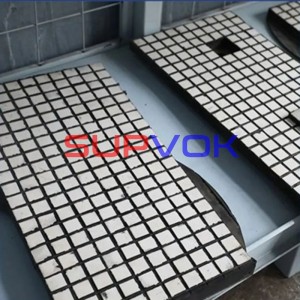
Wear resistant ZTA Ceramic composite liner, ZTA+Rubber+Metal
Wear-resistant ceramic lining plate:
Alumina, silicon carbide and zirconia ceramics are used as wear resistant layers.
Auxiliary metal layers and rubber layers are used as buffers.
Common types:
Rubber composite ceramic lining plate
Metal composite ceramic lining plate
-

ZTA Ceramic Plates, ZTA+Rubber+Metal
Wear-resistant ceramic lining plate:
Alumina, silicon carbide and zirconia ceramics are used as wear resistant layers.
Auxiliary metal layers and rubber layers are used as buffers.
Common types:
Rubber composite ceramic lining plate
Metal composite ceramic lining plate
Product structure
The ceramic rubber steel plate composite liner uses a heat vulcanization process to vulcanize toughened ceramic sheets into a steel plate groove equipped with special rubber, and the steel plate groove is equipped with countersunk bolts. This liner is a customized product that can be made into various shapes. Composite materials of various thicknesses are selected according to wear conditions to make the liner, forming a strong wear-resistant layer. The operating temperature of this product is – 50 ℃ – 100 ℃.
The properties of each material in the three-in-one wear-resistant ceramic lining plate complement each other, forming a wear-resistant and impact resistant panel, which has incredible wear-resistant and impact resistance properties. It can be used in heavy wear industries such as sand and gravel, mining, and other high impact areas.
Product Features
1. The three-in-one wear-resistant ceramic lining plate adopts modular production and assembly, which can replace high wear areas;
2. Provide stud bolt fixation and weldable installation methods;
3. The special rubber heat vulcanization process not only ensures that the ceramic blocks embedded in the rubber layer are firmly bonded, but also acts as a buffer layer to prevent the ceramic blocks from cracking;
4. The shape, size, and thickness of the ceramic block or backing plate can be customized according to your specific working condition or use.
Scope of application
The ceramic rubber plates are widely used as an anti wear lining on equipment with heavy wear and strong impact when transporting bulk materials under normal temperature.
-
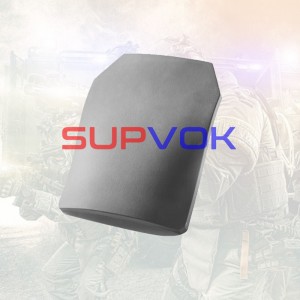
Silicon Carbide Ceramic Bulletproof tiles
Silicon carbide ceramic tiles
The covalent bond of silicon carbide is very strong, and it still has high strength bond at high temperature. This structural feature endows silicon carbide ceramics with excellent strength, high hardness, wear resistance, corrosion resistance, high thermal conductivity, good thermal shock resistance and other properties; At the same time, silicon carbide ceramic is one of the most promising high-performance armor protection materials with moderate price and high cost performance.
Silicon carbide ceramic has broad development space in the field of armor protection, and its application in the fields of individual equipment and special vehicles tends to be diversified. As a protective armor material, considering the cost and special application conditions, small ceramic panels and composite backplates are usually bonded to form ceramic composite target plates to overcome the failure of ceramics due to tensile stress, and to ensure that only a single piece is broken without damaging the whole armor when the projectile penetrates.
-
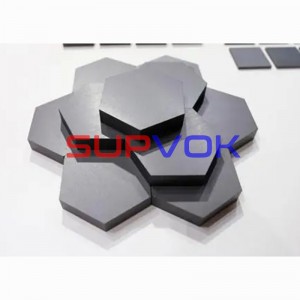
Bulletproof Silicon carbide tiles
Silicon carbide ceramic tiles
The covalent bond of silicon carbide is very strong, and it still has high strength bond at high temperature. This structural feature endows silicon carbide ceramics with excellent strength, high hardness, wear resistance, corrosion resistance, high thermal conductivity, good thermal shock resistance and other properties; At the same time, silicon carbide ceramic is one of the most promising high-performance armor protection materials with moderate price and high cost performance.
Silicon carbide ceramic has broad development space in the field of armor protection, and its application in the fields of individual equipment and special vehicles tends to be diversified. As a protective armor material, considering the cost and special application conditions, small ceramic panels and composite backplates are usually bonded to form ceramic composite target plates to overcome the failure of ceramics due to tensile stress, and to ensure that only a single piece is broken without damaging the whole armor when the projectile penetrates.
Silicon carbide ceramic tiles are also widely used as wear-resistant ceramics.
-
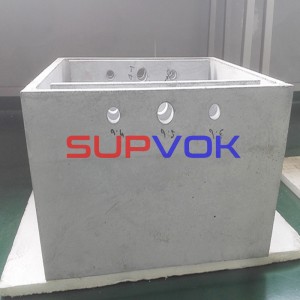
NSiC nozzles – silicon carbide nozzles in power plants
The main function of the silicon carbide nozzle of the burner is to inject the pulverized coal air mixture (primary air) supplied by the pulverized coal preparation system and the secondary air required for combustion into the furnace at a certain concentration and speed, respectively, so as to achieve stable ignition and combustion in the suspended state.
- 1. The structure of silicon carbide nozzle must be simple, not easy to block, easy to repair and replace, long service life, and improve economic efficiency.
- 2. The silicon carbide nozzle adopts an integrated casting molding process, which is high temperature resistant, wear-resistant and reduces maintenance costs.
The burner nozzles of power plant generally adopts cast steel structure. The proper swing of the burner nozzle can change the position of the flame center to adjust the reheat steam temperature level; The thick and thin pulverized coal burner can prevent furnace coking and high-temperature corrosion, and has the characteristics of stable ignition, good combustion stability at low load, and low NOx emission. After the primary air cast steel nozzle of the burner is burnt and deformed, the deviation between the furnace flame center and the design value is large, and the deviation between the nozzle size and the original size is large. The initial momentum of the jet is reduced compared with that before the burning loss, the range is shorter, and the rigidity is poor. The pulverized coal ignites near the nozzle, and the temperature near the nozzle is high, which is easy to produce slagging. The primary air nozzle of the burner needs to be replaced after it is burnt. During the replacement, the powder pipes connected to the outside of the burner need to be disconnected, the primary air nozzle of the burner and the nozzle should be pulled out together, then replaced, and then loaded. The workload is large, the environment is poor, and it costs labor, time, and money, resulting in great economic losses.
The silicon carbide nozzle of the burner produced by our company is wear-resistant, high-temperature resistant, non-deformable, and its service life is 3-5 times that of the cast steel nozzle, which improves the boiler efficiency, reduces NOX emissions, saves energy and environmental protection, reduces maintenance costs, and improves economic benefits.
It adopts integrated molding process, which is resistant to high temperature, abrasion and deformation.
The defects of cast steel nozzle mainly include the following aspects.
1. The nozzle of cast steel is not wear-resistant, corrosion resistant, high temperature resistant and has short service life. The boiler needs to be shut down for replacement, resulting in great economic losses.
2. The cast steel nozzle is easy to be damaged during the operation of the unit, and the blunt body of the nozzle often falls off, threatening the operation of the burner and the safe operation of the slag extractor.
3. Because the nozzle material is G40Cr20Ni5, which works under high temperature for a long time, when the combustion of pulverized coal is unstable, it will cause uneven temperature distribution in the furnace or coking at the nozzle, resulting in thermal stress at the nozzle due to temperature difference, resulting in serious local deformation of the nozzle, short range of primary air, poor rigidity, pulverized coal ignition near the nozzle, high temperature near the nozzle, and local additional stress in the component. When the temperature fluctuation is large, The thermal stress changes greatly, causing thermal fatigue cracks on the nozzle surface, which will cause the burner nozzle and nozzle to burn over a long period of time.
4. Because the primary air flow is a high-speed gas-solid two-phase flow, the uneven scouring of pulverized coal particles leads to serious local wear of the blunt body and even wear off the blunt body. The nozzle and the blunt body are integrated. On the other hand, the thermal stress at high temperature is easy to cause serious deformation of the nozzle, even burning out, so the nozzle can not play its due role.
-

Silicon carbide tiles
Silicon carbide (SiC)
Features of the product:
Silicon carbide ceramic is the lightest and hardest ceramic material. It has excellent thermal conductivity, low thermal expansion, very acid and alkali resistance, and is not easy to crack in cold and hot environments.
Therefore, silicon carbide ceramic is an excellent furnace material and high-temperature wear-resistant part. It also has excellent corrosion resistance and wear resistance.
Product performance:
Very low density: (3.20 g/cm ³)
Very high hardness: (94HRA)
High thermal conductivity: (80 W/mK)
Low linear expansion coefficient: (4.5×10-6/K-1400 ℃)
Maximum service temperature: 1500 ℃
Maintain good corrosion resistance and wear resistance at high temperature
The outstanding characteristics of SiC ceramics:
Low density, high elastic modulus; High strength, especially high temperature strength and low temperature; High hardness and low friction coefficient, excellent wear resistance; Low thermal expansion coefficient, high thermal conductivity, and excellent thermal shock resistance; Good chemical stability and excellent corrosion resistance; The resistivity can be controlled by purity and doping, and has semiconductor characteristics.
2. SiC Product series:
As structural ceramics and high-temperature materials with excellent performance, SiC ceramics have been used more and more in petrochemical, iron and steel metallurgy, mechanical and electronic, aerospace, energy and environmental protection, nuclear energy, automobile, high-temperature kiln and other industrial fields.
(1) Sealing ring and bearing:
Due to its excellent wear resistance, high thermal conductivity, high temperature resistance and corrosion resistance, pressureless sintering and reactive sintering dense SiC material is an ideal material for manufacturing sealing rings, sliding bearings and friction protection shaft sleeves. It can be processed into sealing rings with various shapes and high dimensional accuracy and surface finish, which can be used as mechanical seals in many harsh environments. For example, the sealing device and sliding device used for acid-resistant and alkali-resistant pumps in the shipbuilding, chemical, metallurgy, petroleum and paper industries have been widely used due to their good air tightness and long service life.
Take the application of SiC sealing ring in surface sealing of automobile water-cooled pump as an example. The face seal mainly provides the seal of the rotating interface to prevent the liquid or gas on one side of the seal from flowing to the other side. For the water-cooled circulating water pump device of automobile engine, the ceramic ring seal can avoid water leakage during the rotation of the water pump, and can realize sealing and sliding at the same time. In the past, Al and O ceramics were commonly used, but now SiC materials are used because SiC has higher hardness, better wear resistance and longer service life than AlO. Similar SiC sealing rings are also used in automobile air conditioning compressors.
(2) Bulletproof ceramic
Due to its high hardness, low density, good protective performance and low price (compared with B4C ceramics), SiC ceramics have certain competitive advantages in the application of bulletproof armor. Its protective performance is better than that of AL2O3 ceramics and slightly inferior to B4C ceramics (about 70%~80% of B4C ceramics), but the manufacturing cost of SiC ceramics is far lower than that of B4C ceramics. At present, normal-pressure sintered SiC and reaction-sintered SiC ceramic plates are particularly suitable for occasions with large amounts of protective armor and cannot be too thick and heavy. For example, SiC ceramics with high hardness, high toughness and high Weibull modulus (four-point bending strength is 580 MPa, fracture toughness Kc is. 7MPam1/2, Weibull modulus m=17) prepared by American companies are excellent bulletproof materials.
(3) Nozzle
Various nozzles are needed in the fields of petroleum industry, energy, environmental protection, aerospace rocket and machinery manufacturing. SiC ceramics are widely used because of their higher hardness, thermal shock resistance and excellent corrosion resistance than Al2O3 and Si3N4 ceramics. For example, the service life of SiC ceramic is 3.5 times longer than that of Al2O3 ceramic. Reactive sintering, pressureless sintering and recrystallized SiC can be used as burner nozzles in high-temperature kilns and desulfurization nozzles for desulfurization and dust removal in thermal power plants.
(4) Grinding plate Grinding plate is an important process equipment for the production of silicon wafers for ultra-large-scale integrated circuits in the semiconductor industry. Generally used cast iron or carbon steel grinding plates have short service life and large thermal expansion coefficient. In the process of processing silicon wafers, especially in high-speed grinding. During polishing, the flatness and parallelism of the silicon wafer are difficult to be guaranteed due to the wear and thermal deformation of the grinding plate. Because of its high hardness and low wear, and its thermal expansion coefficient is basically the same as that of silicon wafers, the grinding disc made of silicon carbide ceramics can be grinded and polished at high speed. In recent years, the size of silicon wafers has become larger and larger, and higher requirements have been put forward for the quality and efficiency of silicon wafers. The use of SiC ceramic abrasive discs will significantly improve the quality and efficiency of silicon wafer grinding. SiC ceramic abrasive discs manufactured by Kyocera Corporation, Toshiba Ceramics Corporation, and Caballendon Corporation of the United States have been used in the semiconductor industry.
(5) High temperature heat exchanger
In many cases, for example, in metal and glass furnaces, furnaces and coal burning furnaces, the gas emitted is not only high temperature but also corrosive, which requires that the heat exchanger also have high temperature resistance, corrosion resistance and thermal shock resistance, and can withstand large thermal stress. Another performance requirement for heat exchanger materials is high thermal conductivity to maximize heat transfer rate and heat exchanger efficiency. SiC has been the main material of industrial heat exchanger for a long time because of its high thermal conductivity, excellent high-temperature resistance, corrosion resistance and good thermal shock resistance. For example, the SiC heat exchanger of steel forging furnace has been put into use for more than 500000 hours since 1985, and the use of SiC heat exchanger in Hao remelting furnace can save 38% of fuel.
(6) Thermal engine parts
The outstanding high temperature strength, excellent high temperature creep resistance and thermal shock resistance of SiC ceramics make it one of the main materials for thermal engine components in rockets, aircraft, automotive engines and gas turbines. For example, the AGT100 automotive ceramic gas turbine developed by General Motors uses SiC ceramics as high-temperature components such as combustor ring, combustor barrel guide vane and turbine rotor. These SiC components are mainly prepared by reactive sintering, pressureless sintering or hot-pressing sintering. Due to the poor toughness of SiC ceramics, they are mainly used as static heat engine components in engines or gas turbines.
(7) High temperature seal
Both recrystallized SiC and solid-phase normal-pressure sintered SiC ceramics are excellent high-temperature sealing materials, which can be used as high-temperature crossbeam sticks, shed plates, saggers, etc., and the service temperature reaches 1600C, as shown in Figure 8-13 (b) and (h). SAINTGOBAIN, France, uses pressureless sintered SiC ceramics to make the beam of high temperature sealing tool, which has the characteristics of self-bonding and fine grain (<10 um) microstructure, and its high temperature strength and oxidation resistance are very excellent. Under the condition that the bending strength at 1700C is maintained above 400 MPa and 1100C wet steam, the oxidation weight gain is far less than that of recrystallized SiC and SiN-bonded SiC ceramics.
-
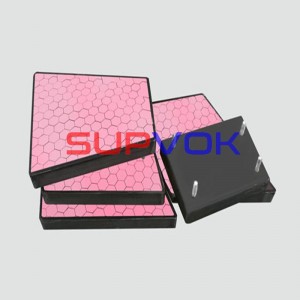
Wear resistant RBSiC and SSiC plates, blocks, tiles, ceramic and rubber plates
Silicon carbide ceramic tiles
The covalent bond of silicon carbide is very strong, and it still has high strength bond at high temperature. This structural feature endows silicon carbide ceramics with excellent strength, high hardness, wear resistance, corrosion resistance, high thermal conductivity, good thermal shock resistance and other properties; At the same time, silicon carbide ceramic is one of the most promising high-performance armor protection materials with moderate price and high cost performance.
Silicon carbide ceramic has broad development space in the field of armor protection, and its application in the fields of individual equipment and special vehicles tends to be diversified. As a protective armor material, considering the cost and special application conditions, small ceramic panels and composite backplates are usually bonded to form ceramic composite target plates to overcome the failure of ceramics due to tensile stress, and to ensure that only a single piece is broken without damaging the whole armor when the projectile penetrates.
Silicon carbide ceramic tiles are also widely used as wear-resistant ceramics.





